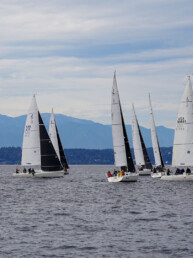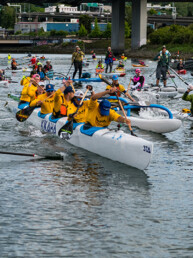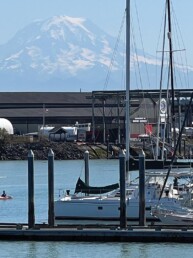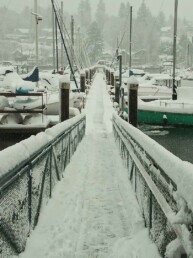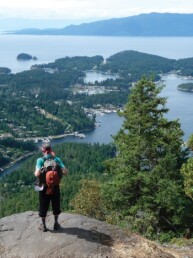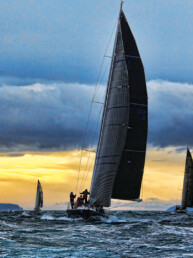This article was originally published in the March 2022 issue of 48° North.
After nearly a year of planning, the time had come for the 15th running of the annual Deception Pass Challenge. In the past, the race has had as many as 200 participants, and for this stormy year, 79 racers showed up at the start on December 11, 2021. When it was all said and done, what many participants thought was a great day on the water became national news. Those on (or in) the water would describe it as “epic” and “adventurous.” Some land-based observers would later describe it in the media as “irresponsible.”
So what, exactly, happened? And what can Pacific Northwest mariners learn from the experience?
The Race

The 6-mile race starts just outside Deception Pass in Bowman Bay and threads a course around Deception Island, through the pass, around Strawberry Island and back. It was conceived by Don Kiesling as a sea kayak race, and is now directed by veteran paddling race organizer, Rob Casey. Over the years, the
race has evolved, and this year involved four conceptually different types of human-powered craft: rowing craft, kayaks, canoes, and stand up paddleboards (SUPs). Within each of those groups there are specialized types — surf skis, OC-1s, and OC-2s, among others.
This is no ordinary race. These aren’t ordinary boats. And certainly these aren’t ordinary people. Challenging and rewarding, the race covers ground most participants have used as a “playground,” honing their skills with currents, eddy lines, waves, and rocks. Deception Pass has a similar draw to paddlers as Yosemite has to climbers.
Like Yosemite, the race attracts some of the best paddlers in the region, if not the world, to undertake challenges that many might think of as extreme. Participants in the 2021 event had competed in races between Hawaiian Islands, down the Columbia River, across the Strait of Juan de Fuca, and from Victoria, BC, to Ketchikan, Alaska. By all accounts, they were skilled, competent, and experienced.
The Boats
The Deception Pass Challenge relies on both internal and external support craft, arranged in advance. There were six skilled kayakers and a SUPer prepositioned to support in key areas where capsizing is more likely. The race-associated support vessels also included a SeaStrike — a jet-ski-type craft purpose-built for surf rescue, with inflatable pontoons on the sides for stability.
The external support craft included a boat from Skagit County Search and Rescue (SAR), a Skagit County Sheriff’s boat; as well as two USCG cutters, one prepositioned and the other transiting the area by coincidence.
A thorough Zoom safety briefing prior to the race focused on the course and safety protocols, with emphasis on personal accountability. Participants were told to be ready for immersion, to wear PFDs, and to use VHF radios to communicate with the race organizers and rescue teams. Although there were plenty of support vessels around, racers were encouraged not to rely on them — the best rescue is a self rescue.
The different types of crafts in the race have strengths and weaknesses. In flat water, the rowing shell is the fastest. In rough water, however, those advantages evaporate. In contrast to a rowed boat, the highly maneuverable SUP shines in larger waves, has the advantage of being tethered to the paddler, and can provide assistance to a swimmer. Falling off is part of the drill and a skilled SUPer can remount the board quickly and continue on.
Kayaks and canoes lie between rowers and the SUPs when it comes to rough water ability. The OC-1 and OC-2 canoes are ocean racing canoes with outriggers or amas. Designed in the 1980s, racers take on full ocean swells in Hawaii and Southern California with both short and long distance race schedules. The kayaks break down into two distinct groups: traditional sea kayaks and the ‘surf ski’, a narrow racing kayak that one sits on, has no spray skirt, but a self draining cockpit. A skilled sea kayaker can roll their craft and pop upright after an unexpected flip. It’s also possible in a surf ski, but is more difficult.
Race Day
In the early hours of Saturday morning, Chief Master Grant Heffer, Captain of the 87-foot Coast Guard cutter Adelie, was coming down Rosario Strait. A gale had raged for days and the warning was still in effect, but the notice expired at 10 a.m. Saturday morning. In 8-foot seas, Heffer described the trip as “sporty.” The Adelie’s presence at the Deception Pass Challenge was not technically required, but the combination of weather and location was reason enough to make the trip.
The racers arrived at the starting area in Bowman Bay to find it relatively quiet and shielded from the wind slightly offshore. In nearby Anacortes, Sheriff Brian Morgan’s description mirrored what the racers saw. The 6-10 foot waves experienced by Captain Heffer and his crew were not visible from the shore, nor were the sustained 20 to 30 knot winds.
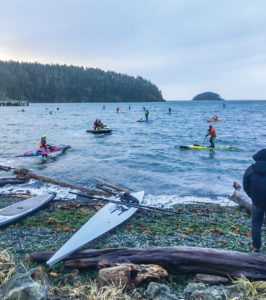
Check in began at 8 a.m. and it appeared as if the weather might cooperate. Given the forecast, many would-be racers bailed, on the bet the race would be canceled or perhaps it was above their comfort level. By the time the designated time keeper, Harry Oesterreicher, had checked everyone in, there were 11 kayaks, 8 OC-1s, 6 OC-2s, 5 rowing shells, 18 SUPs, and 14 or 15 surf skis. With the addition of race associated support paddlers, there were some 80 vessels and 100 people on the water.
There were two starts, the first for the slower craft — sea kayaks, wider SUPs, or folks who knew they were slower than the more ‘racy’ contestants. The second start was for the faster craft.
Andrew Hansen had driven up from Portland, towing his 11-foot SeaStrike, a powerful and capable craft purpose-built for rough water-level rescues. An experienced paddler with kayaks, surf skis, and SUPs (including a California River Quest 100 mile race under his belt), Hansen bought the SeaStrike to support his fellow paddlers, give back to the community, and, candidly, for “FUN!”
Driven by Hansen with his rider, Lee, they stood off the starting line when Oesterreicher gave the signal for the first start at 9:07:29.6 a.m. The chop had picked up a little but was not a problem, given the experience levels of the paddlers. Around this time, Sheriff Morgan began to notice the wind shift and, along with that, increased wave activity in Bowman Bay.
A surf ski took the lead, pulling away from the others and Hansen followed him to, then around, Deception island. The conditions were worsening, but the surf ski paddler was in control — no problems at all. Several other paddlers followed as Hansen patrolled the area, taking note of the building waves, which in relatively short order were up to 8 feet from the bottom of the trough to their peaks.
After several paddlers had gone around the island, one OC-1 went over. Hansen maneuvered to within 4 feet of the paddler, but he got quickly back in his seat with no assistance required. A few seconds later another wave dislodged him from his seat and sprawled him spread-eagle across his ama; but again, he was quickly back in his seat, under control and paddling on.
For the faster racers, Oesterreicher gave the second starting signal at 9:20:50.3. Experienced paddler, Darrel Kirk, 60, was in that start and paddled through the mouth of Bowman Bay, balancing against the uneven waves bouncing off the vertical rocks creating an uneven pattern. Called ‘reverb’ by paddlers, experienced SUPers train for this scenario and know how to recognize it.
About two-thirds of the way towards Deception Island, some of the rowers began having challenges. In any deteriorating situation, it’s never quite clear when a line is crossed; but for rowers, wherever that line was, it was behind them.
Watching from his cutter, Captain Heffer wasn’t too concerned when he saw some of the boats capsize. He had kayaking experience and knew that skilled paddlers could roll or employ other techniques to self-rescue. He had his coxswain and another crew member on standby with his stern-launched 17-foot diesel powered jet boat, but he refrained from launching them at first.
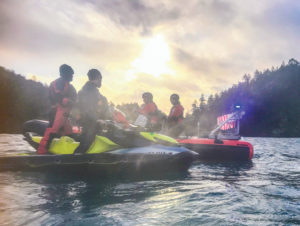
When it was apparent that a few of the rowers and paddlers were having difficulty getting back into their boats, Heffer launched his jet boat. Around that time another Coast Guard cutter, the Bellingham-based Sea Lion was transiting the area and inquired if the Adelie needed assistance. Heffer, in his words, “called an audible,” and the Sea Lion launched its small boat as well.
All those that I interviewed — paddlers, rowers, and law enforcement — described the abrupt weather change as the first wave of racers was about to start. The wind increase and directional change sent conditions from acceptable prior to 9 a.m. to arguably unacceptable by around 9:30 a.m.
As waves built, most of the skilled SUPers started to smile more broadly. This was their element. The rowers were more grim with their struggle to stay upright. Two of the rowers went over, and while there were race-associated safety boats nearby, so was the Skagit Valley Sheriff’s boat and the boats off the two cutters.
Assist or Rescue?
There is an interpretive distinction between the words “assist” and “rescue” — but both are typically genuinely appreciated. The gray area between assist and rescue came up in a Sheriff boat’s response to a participant who was in the water, but was coherent and in full command of their facilities, as reported both by this participant and a safety SUPer who was in eye contact with this person. While the safety SUP was in position and able to assist, observers saw the Sheriff boat respond in rescue fashion — making a few passes from leeward and being blown downwind away from the person in the water. Finally, a windward approach allowed the participant to be hauled aboard. That participant told me that they never felt truly in danger, given the other people in the immediate vicinity.
Around 9:30 a.m., Sheriff Morgan called the race. He’d seen enough and reports from his rescue boat were of multiple capsizings. He wanted all participants to return to Bowman Bay.
At this point, things became somewhat hectic. On shore, Oesterreicher recalls being told twice to cancel the race and, on the second request, he broadcast on VHF 69 that law enforcement had canceled the race. Some participants, hearing this, immediately turned around. Others adopted a wait-and-see approach as conditions, in their judgment, were still within their capabilities. Still others continued having difficulties and were responding with a mix of self rescues, assists from fellow paddlers, and some help from law enforcement boats.
The shifted wind was now blowing right into Bowman Bay, with breakers and large pieces of driftwood crashing on the shore. While Sheriff Morgan was calling for aid cars for a possible mass casualty event, Darrel Kirk, part of the second wave, was still going outbound, not yet quite believing what was happening. Conditions were getting more challenging, but he was having fun. Lots of fun. Waiting to see what most of his competitors would do, eventually, and with some reluctance, he too started to paddle back.
There were more capsizings. In one, a kayaker went over and was unable to roll upright. Bailing from the boat, the kayaker was initially assisted by a paddling buddy. This maneuver isn’t risk free, the weight of the second person on the kayak can alter the balance and, in this case, the rescuing kayak rolled and put both paddlers in the water. One of the safety SUPs, paddled by Holly Rasumuson, watched the events and offered her support. The rescuing kayaker was able to get back into his boat, but the original swimmer climbed on to the back of Holly’s board. Shortly thereafter, one of the USCG zodiacs pulled alongside and, with few words, pulled the kayaker off the board.
The number of “rescues” reported by some media outlets was “more than 20.” Accounts vary slightly, but it appears the number of folks who got into a law enforcement boat was between four and seven. Far more were aided by fellow paddlers or were able to self rescue. The larger craft played a critical role, but from the interviews, it seems that most would generally fall under the category of assists rather than rescues.
At the end of the day, all participants were accounted for and the only reported injury was a hand that got squeezed between an oar and the Sheriff’s boat. Ashore, there was some additional drama as racers returned. Oesterreicher was keeping record of the participants using the scoring software and he found himself facing dozens of paddlers coming in across more than 100 yards of beach, each picking a safe path to land. He solicited help from runners and began recording the times of those returning and handed off the iPad to Susan Wescott, who recorded participant’s names.
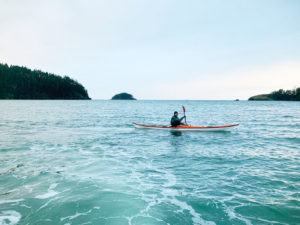
Initially, there were two kayakers whose names did not get checked off. These participants were seen safely ashore, but for several minutes it became a situation where the organizers knew they were safe, but unable to prove they were safe. Momentary chatter about “missing participants” did little to calm the nerves of the late-arriving aid units summoned by the Sheriff.
The Takeaways
After chatting with those on the water and the captain of the Adelie, there emerged a consensus view that no one was ever in serious mortal danger. The participants I talked to range in their comments between, “It was just getting fun, I would have been able to go on,” to, “In retrospect, I should have turned around earlier.” Most generally agreed with the decision to call the race and chalked it up to wild weather. Captain Heffer summed it up best: “It was billed as an adventure race and it was an adventurous day.”
Despite the issues, many things went right. Everybody returned safe and there were no significant injuries. The training and practice of the vast majority of the participants were up to the conditions. The safety planning and protocols by the organizers worked. The Coast Guard, Sheriff, and SAR boats’ assistance was genuinely appreciated.
Yet, there were lessons learned, and the following list is far from complete. Rob Casey, the race organizer, was coordinating from the water, not on shore — which proved difficult for communication. One of Captain Heffer’s observations was the challenging lack of “go/no-go” parameters in advance. The Skagit County Sheriff noted some issues with on-the-water communication via VHF, and that support vessels should consider a coordinated “race canceled” signal (smoke or sound signal) that could be more readily seen or heard over a broad expanse of water.
From this writer’s perspective, there are conditions that may be right for certain craft, but exceed the tolerance for safety for even experienced paddlers in other types of craft. I also see room for more communication with law enforcement.
For those on the water, it was a great day — a big adventure and challenge that left them with wide smiles and stories to tell. For those on land and some armchair observers, it provided fodder for commentary and concern. After hearing from so many participants, I now share the racers’ perspective about
the 2022 Deception Pass Challenge.

